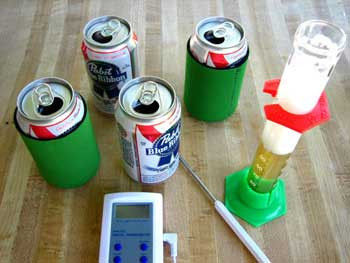
The Experiment
Beer drinking is one of the world’s favorite pastimes. So as the weather started heating up, we felt a scientific duty to investigate this burning beer-related question: what is the most effective beer can cozy?
We took temperature measurements using a digital thermometer with a metal probe. In most of the experiments, the probe was submerged 5.5 cm into the beer, at the approximate midpoint of the can. All experiments were performed outdoors, with ambient temperatures varying from 90F (32.2C) to 103F (39.4C). Except as noted, all beverages used were 12 oz. (355ml) domestic beers. The starting temperatures for the beers ranged between 35.7F (2.1C) and 43.7F (6.5C)

How Effective Are Beer Cozies?
One of the first questions we must address is: Do beer cozies actually work? Do they keep canned beverages cold, or are they just another platform for humorous slogans and advertising logos? To determine the effectiveness of various types of cozies, we selected five representative models that typified widely available beer can cozies:
A can holder made by Coleman, made of a red vinyl-like material
A neoprene cozy imprinted with a camouflage design
A premium model made of a pewter casing with a black foam liner, embossed with the number and colors of NASCAR racer Jeff Gordon
A foam rubber cozy imprinted with a humorous slogan
A soft vinyl/plastic-like cozy with the colors and number of NASCAR racer Tony Stewart
We tested these cozies for an hour and measured the temperature of their contents against those of an uninsulated beer can.
Staging Area: Wooden table on covered patio
Ambient Temperature: 103F (39.4C)
Initial Beer Temperature: 37F (2.8C)
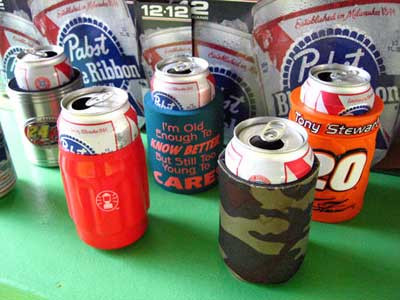
Results: All of the cozies had some effect and kept beer colder than the uninsulated can. Out of the five, the two that performed the best were the most expensive model, the metal and foam NASCAR cozy, and one of the least expensive, the foam rubber model. The terminal temperatures of the beer in each was 59.3F (15.2C) and 59.5F (15.3C) respectively – about 15 degrees below the final temperature of the naked can (74.3F/23.5C). The neoprene cozy and the plastic NASCAR cozy were both reasonably effective, keeping the beer 9.4 (64.9F/18.3C) and 11.2 (63.1F/17.3C) degrees cooler, respectively. The Coleman can holder was the least effective, keeping the can only 7.2 degrees cooler (67.1F/19.5C)
Conclusions: Depending on their material, beer can cozies can be effective in keeping beer cool even in extremely hot weather. The two cozies that performed the best employed a layer of dense foam about half an inch thick, which prevents heat transferring into the cans and the beer by limiting convection and conduction. A cheap beer cozy can be just as effective as a more expensive cozy, provided you get the right type. On the other hand, an ineffective can cozy, while it may improve your grip on the can or keep your hand dry, will not do much to keep your beer cold.
Bottle Cozies
We also tested the effectiveness of zip-up neoprene bottle cozies, comparing different colors of cozies and testing different colors of glass bottles.
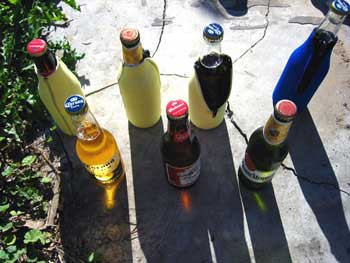
Staging Area: Concrete pad, direct sunlight
Ambient Temperature: 92F (33.3C)
Initial Beer Temperature: 36.5-40.1F (2.5-4.5C)
Our first experiment with bottle cozies had multiple goals: to establish the effectiveness of bottle cozies; to determine if the color of the cozy affected warming; and to determine if the color of the bottle affected the rate or degree of warming. We used three types of beer in differently colored by similarly shaped bottles: Pilsner Urquell (green), Budweiser (brown), and Corona (clear). We tested neoprene bottle cozies in yellow and dark blue. The dark blue cozy was placed on a clear Corona bottle and its results compared to an identical Corona bottle in a yellow cozy.
Results: After one hour, the unprotected bottles had all heated to more that 90F(32.2C), compared to the protected cozies, which were about 20 degrees cooler.
The color of the glass apparently had a slight but measurable effect. In both the insulated and uninsulated cans, the clear Corona bottle stayed the coolest, with the Budweiser and Pilsner bottles about 2 degrees warmer, and this despite the Pilsner starting out nearly a degree colder.
The dark blue cozy proved a less effective insulator than its identical yellow counterpart. The beer in the dark blue cozy was 7.5 degrees warmer (79.1F/26.2C) than the beer in the yellow cozy (72.6F/22.3C).
Conclusions: The bottle cozies were effective, although one hour was clearly too long to leave a bottle sitting out, with or without insulation. The fact that the green and brown bottles warmed up slightly more appears to be consistent with the fact that dark materials absorb more radiation and therefore more heat; however, the results may have been due to some other unknown factor, such as the thickness of the glass or the effect of the bottle labels. The higher temperature of the beer in the dark blue cozy was definitely the result of the darker material absorbing more heat. Lighter colored cozies are more effective.
Food Fight
Bagels vs. Donuts vs. Rice Krispies Treats vs. Traditional Foam Cozy
Staging Area: Wooden table on covered patio
Ambient Temperature: 103F (39.4C)
Initial Beer Temperature: 38F (3.3C)
In this experiment, we faced three types of carbohydrates off against a typical beer can cozy. The bagels and donuts we prepared in a similar manner – cutting a can-sized section out of the middle and stacking them three high. The Rice Krispies Treat beer cozy was a more elaborate production, which we have fully detailed here.
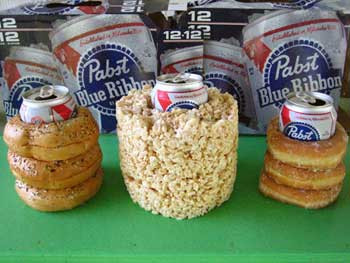
Results: Over the hour test period, the Rice Krispies Treat cozy kept the can more than 2 degrees cooler (60.4F/15.8C) than the standard foam cozy (62.6F/17C). The bagels insulated reasonably well (63.5F/17.5C), while the glazed donuts came in last at 65.8F (18.8C).

How to make a Rice Krispies Treat Cozy
Conclusions: All of our food-based can cozies worked to some degree, but the Rice Krispies Treat cozy stole the show. We theorize that its superior insulating ability probably comes from the thickness of the material combined with the Styrofoam-like quality of the Rice Krispies Treats. And as gratifying as it would have been to see a successful synergy between beer and donuts, the bagels were slightly better insulators, perhaps because they are denser than the raised glazed pastries.
Which Is the Coolest?
Lego vs. Knitted Cozy vs. Terry Cloth Wristbands vs. Hair Scrunchies vs. Traditional Foam Cozy
Staging Area: Formica table on covered patio
Ambient Temperature: 103F (39.4C)
Initial Beer Temperature: 37.5F (3.1C)
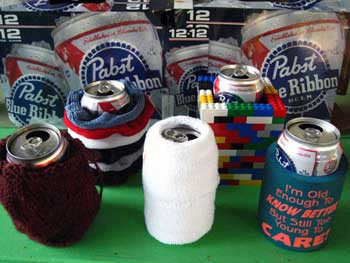
In this experiment, we tested different can cozy materials to see how their “coolness” in terms of cultural cachet measured up against their literal coolness as insulators. Since Lego building blocks are enjoying a resurgence in popularity, we used them to build a can holder. Thanks to the crafting craze, anything knitted is now hip, so we commissioned a friend to knit us a can cozy. And though they may be on their way out by now, we’ve noticed hipsters wearing terry cloth head bands and wristbands, so we tried slipping a couple over a can. For their “unhip” competition, we chose hair scrunchies and a typical foam can cozy with a cheesy slogan on it.
Results: While we strive for scientific detachment and objectivity, we admit we had high hopes for the Lego can cozy because of its aesthetic and nostalgic appeal. Somewhat disappointingly, the Lego cozy came in second to last; after one hour, the beer was 63.5F. It proved to be an adequate, but not spectacular insulator, and was about as effective as a slightly sub-par can cozy. We suspect that part of the issue was the relatively large space between the inside wall of the cozy and the can, which allowed warm air to circulate around the beer. This design flaw was a result of the dimensions of the Lego blocks, which necessitated making the container slightly larger than needed in order to fit the can inside. This also made the cozy somewhat difficult to grasp.
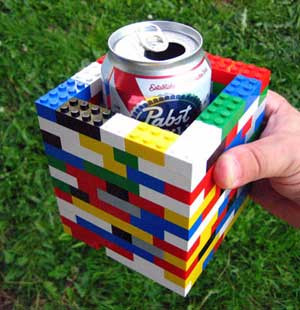
The knitted cozy performed better than we expected. Not only is it figuratively “cool,” it was literally cool. Although you think of wool sweaters and socks as keeping you warm in winter, wool is a good insulator, period. It can keep things cool, as well, because it keeps air from moving, preventing heating through convection.
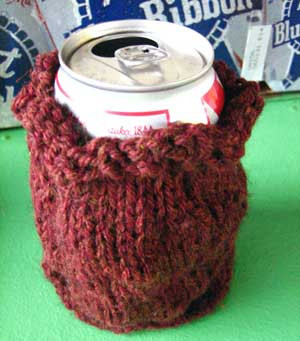
The wristbands, however, were underachievers. Since they were white, they might have had an edge had the experiment been staged in direct sunlight, since white deflects the heating radiation of direct sun better than darker materials. As it was, they were the least effective insulator, leading us to believe they are now passé in terms of coolness. Even the hair scrunchies (uncool) kept the can colder by a couple of degrees.
The clear winner in this contest was the least “cool” cozy, a quintessential foam can holder imprinted with a questionably humorous saying, purchased at a truck stop for 99 cents. Despite its lack of charm, it was the most effective insulator, keeping the beer 59.1F (15.1C) after an hour.
Conclusions: Hipster culture regularly recycles the uncool into the cool. Witness the ascent of lowbrow or trailer park chic and resulting popularity of trucker hats, PBR, slogan T-shirts, and hideous oversized ‘80s sunglasses. Perhaps this undistinguished foam can cozy actually is in fact the coolest of the cool, and we just haven’t recognized it yet.
DIY Showdown
Cardboard vs. Styrofoam vs. Bubble Wrap vs. Foil vs. Space Blanket Foil vs. Traditional Foam Cozy
Staging Area: Wooden table on covered patio
Ambient Temperature: 102F (38.9C)
Initial Beer Temperature: 35.7F (2.1C)
We cobbled together a selection of homemade cozies from a variety of materials, most of which proved to be adequate insulators
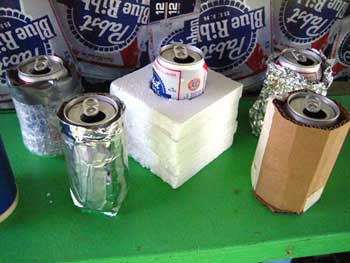
Results: We were very curious what the space blanket would do, since it claims to have unique thermal capabilities. Theoretically you’re supposed to use it when you’re hiking and get stranded in the woods overnight; it will prevent hypothermia by reflecting 80% of your radiated body heat back to you. And it may discourage bears from attacking, since they don’t like that metallic taste in their mouths. However, we discovered it won’t keep your beer very cold, as it came in last in our trial with a final temperature of 65.4F.
A big, unwieldy chunk of Styrofoam was the best insulator in this round, keeping the beer 2 degrees colder (55.7F/13.2C) than the traditional cozy (57.7F/14.3C). Regular crumpled aluminum foil (58.4F/14.7C) and cardboard (59.5F/15.3C) also fared pretty well, and even plain bubble wrap (60.0F/15.6C) kept the can about 15 degrees cooler than the uninsulated can (75.6F/24.2C).
Conclusions: If you’re in a pinch and you need to keep a can cold, there are a number of common materials that will protect your beer from the scalding rays nearly as well as a regular cozy. A simple tube of cardboard or foil works just fine.
The Cadillac of Can Cozies
Thermos Thermax Can Cooler vs. Pewter and Foam NASCAR cozy vs. Traditional Foam Cozy
Staging Area: Wooden ledge, semi-shaded
Ambient Temperature: 92F (33.3C)
Initial Beer Temperature: 43.7F (6.5C)
One of our cozies was a late entry, but highly anticipated for its claims of thermal superiority. The Thermax Can Insulator, manufactured by Thermos and retailing for about $13.25, advertised on its packaging that it that it would outperform any comparable product, keeping a can cool for 3 hours and 10 times longer than an uninsulated beverage. As a bonus, this item was embellished with a promotional logo for high-end imported Cohiba cigars – a real contrast to the working-class themes of our other can cozies. So how did this fancy-schmancy can cozy stack up against its plebian competitors? We set out the cans and waited for things to heat up.
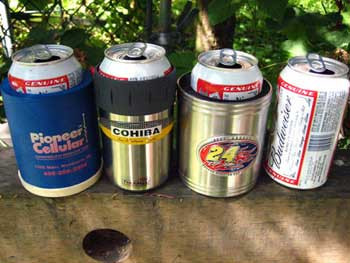
Results: We waited…for a full three hours, to verify the manufacturer’s claims. We found that the Thermos can cozy did indeed outperform the two most effective cozies from our previous trials, a traditional foam can cozy, and the pewter and foam Jeff Gordon commemorative NASCAR cozy. After one hour, the beer in the Thermos can holder was 53.4F (11.9C), compared to 58.6F (14.8C) in the foam cozy and 58.2F (14.6C) in the pewter and foam cozy. The uninsulated can was 69.2F (20.1C). So, it lived up to one of its claims by outperforming any cozy we could find.
How about its two other claims? The box said it could keep a beverage “icy cold 10 times longer than an uninsulated can.” We were at a bit of a disadvantage because our beer didn’t start as icy cold as it could have (43.7F/6.5C). But for the purposes of our experiment, let’s say generously that anything under 50F qualifies as “icy cold.” According to our measurements, the uninsulated can would have hit 50F at about t=10 minutes. So the Thermos can holder would have to keep the temperature under 50F (10C) for t=100 minutes. In reality it broke 50F at around t=35, so it only kept the beer “icy cold” for 3.5 times as long as an uninsulated can. All the same, at t=100, the beer was still only about 58F (14.4C), which isn’t bad, considering the beer in the bare can had warmed to about 77F (25C).
As for its claim that it could keep a drink cold for 3 hours, again, this is somewhat subjective based on what you consider drinkable, and how hot the ambient temperature is (a 60 degree beer on a 100 degree day might seem cooler than on a 78 degree day). In any case, after 3 hours, the beer in the Thermos holder was 66.7F (19.3C) (most cold tap water is colder), having gained a total of 23 degrees. Nevertheless, the can was still cool to the touch. Had we started with colder beer (say, 33F), the terminal temperature would have been around 56 (13.3C) degrees , which is sort of cold.
Conclusions: We will grudgingly allow that the Thermos can holder met its advertised claims. It outperformed comparable cozies, kept a beer cool several times longer than an uninsulated can, and held the temperature reasonably low for 3 hours. Of course, after 3 hours, the beer was flat and completely undrinkable, so the value of this particular feature is questionable. If you really want a superior can cozy, this is the one to buy, but if you drink your beer at anything resembling a normal rate, it won’t make much difference.
Other experiments:
How Many Condoms Can You Wear at Once?
Does Viagra Keep Flowers from Wilting?
The Cheney Shotgun Experiment
What is the Ultimate Jello-Shot?
How to Light a Jell-O Shot on Fire